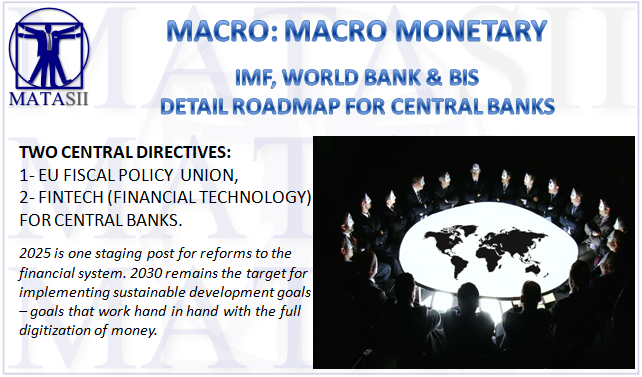IMF, WORLD BANK & BIS DETAIL ROADMAP FOR CENTRAL BANKS
During the Spring Meetings in Washington DC, the IMF and World Bank held their annual Development Committee conference which looked at the economic outlook and potential risks for the global economy. This along with recent reports from the BIS (Bank of International Settlements) lay out the consensus direction for global central bankers.
TWO CENTRAL DIRECTIVES
1- EU FISCAL POLICY UNION
The IMF make it clear that ‘the 2030 Sustainable Development Goals cannot be achieved‘ without ‘robust and inclusive growth‘. This is a roundabout way of saying that widescale reforms of financial and ecological systems are necessary for globalists to fulfil the objectives mapped out by the UN.
Looking at fiscal policy first, the statement reads:
Fiscal policy needs to generate space for priority development spending, while at the same time preserving public debt sustainability. This requires tax policies and administrative reforms that broaden the tax base and enhance revenue collection, as well as prudent debt management. Increasing the efficiency of public spending is also needed, including in priority areas such as education, health, and infrastructure.
Translation:
- A fiscal union within the EU would represent a major advancement in the project for European integration.
- In 2018 the IMF published a paper detailing the case for a fiscal union in the Euro Area. This was followed by a short precis titled, ‘The Euro Area Needs a Fiscal Union.’
- Without a fiscal union in place, the IMF’s position is that ‘the architecture supporting Europe’s currency union remains incomplete and leaves the region vulnerable to future financial crises.’ They outline the solution as consisting of a ‘common fiscal policy‘, brought to fruition in the name of preserving ‘financial and economic integration and stability‘ and ‘sharing fiscal risk‘.
- In the IMF’s words, a fully realized fiscal union would need ‘effective rules and institutions to contain it.’ They readily admit that for such rules to get off the ground would likely require ‘moving some decision-making power from the member states to the central level.’
The economic jeopardy caused by unsustainable levels of debt is a vehicle which globalists may attempt to utilise in a bid to gain full spectrum control over national budgets.
2- FINTECH (FINANCIAL TECHNOLOGY) FOR CENTRAL BANKS
Along with efforts towards a fiscal union is the development of Financial Technology (Fintech).
- Fintech relates directly to the rise of digital money through the use of cryptocurrencies and the future issuance of central bank digital currencies (CBDC’s).
- Both the BIS and IMF have begun to openly question ‘money in the digital age‘, whilst central banks are in the midst of reforming national payment systems that will be compatible with distributed ledger technology (DLT).
- New issues are also being raised by the introduction of new products that fall within cross-sectoral regulatory gaps, and that are outside existing legal definitions. Such products require adapting prudential regimes and modernizing the legal frameworks.
Recent developments in retail payments systems suggest a move toward real-time settlements, flatter structures, continuous operations, and global reach. Coinciding with these developments, an increasing number of countries are experimenting with, or researching, Distributed Ledger Technologies (DLT) for use in financial market infrastructures, although few countries have carried out pilot projects.
- We also learn from the speech that the Eastern Caribbean Central Bank and the Central Bank of the Bahamas are in the advanced stages of carrying out ‘blockchain-based CBDC pilots‘. The Riksbank of Sweden, a country that is rapidly becoming cashless, is also advancing plans to issue what is termed an ‘e-krona‘ currency.
- Fintech provides ‘new opportunities for central banks to improve their services – including issuing digital currency.’ A recent blog post of mine (BIS General Manager Outlines Vision for Central Bank Digital Currencies) looks into this in more detail.
If globalists ever manage to successfully present CBDC’s as a solution to economic crisis – one that the general population buys into – that is when their rise will be unstoppable.
[SITE INDEX -- MACRO: MACRO MONETARY]
READERS REFERENCE (SUBSCRIBERS-RESEARCH & PUBLIC ACCESS )
MACRO: MACRO MONETARY
MATASII RESEARCH ANALYSIS & SYNTHESIS WAS SOURCED FROM:
ABSTRACTED FROM: 04-24-19 - Steven Guinness - "Globalists Detail Short- And Long-Term Guidance For Further Centralisation Of Powers"
FAIR USE NOTICE This site contains copyrighted material the use of which has not always been specifically authorized by the copyright owner. We are making such material available in our efforts to advance understanding of environmental, political, human rights, economic, democracy, scientific, and social justice issues, etc. We believe this constitutes a 'fair use' of any such copyrighted material as provided for in section 107 of the US Copyright Law. In accordance with Title 17 U.S.C. Section 107, the material on this site is distributed without profit to those who have expressed a prior interest in receiving the included information for research and educational purposes. If you wish to use copyrighted material from this site for purposes of your own that go beyond 'fair use', you must obtain permission from the copyright owner.
NOTICE Information on these pages contains forward-looking statements that involve risks and uncertainties. Markets and instruments profiled on this page are for informational purposes only and should not in any way come across as a recommendation to buy or sell in these assets. You should do your own thorough research before making any investment decisions. MATASII.com does not in any way guarantee that this information is free from mistakes, errors, or material misstatements. It also does not guarantee that this information is of a timely nature. Investing in Open Markets involves a great deal of risk, including the loss of all or a portion of your investment, as well as emotional distress. All risks, losses and costs associated with investing, including total loss of principal, are your responsibility.


